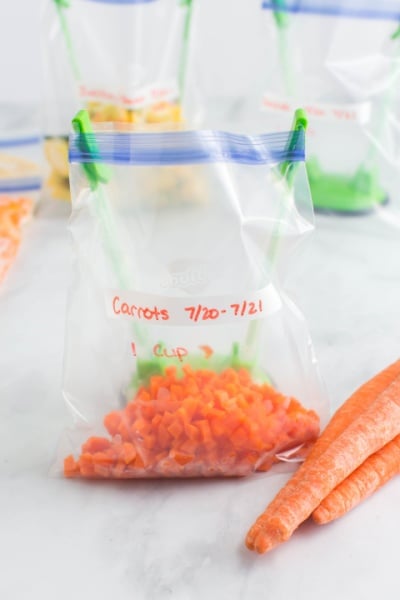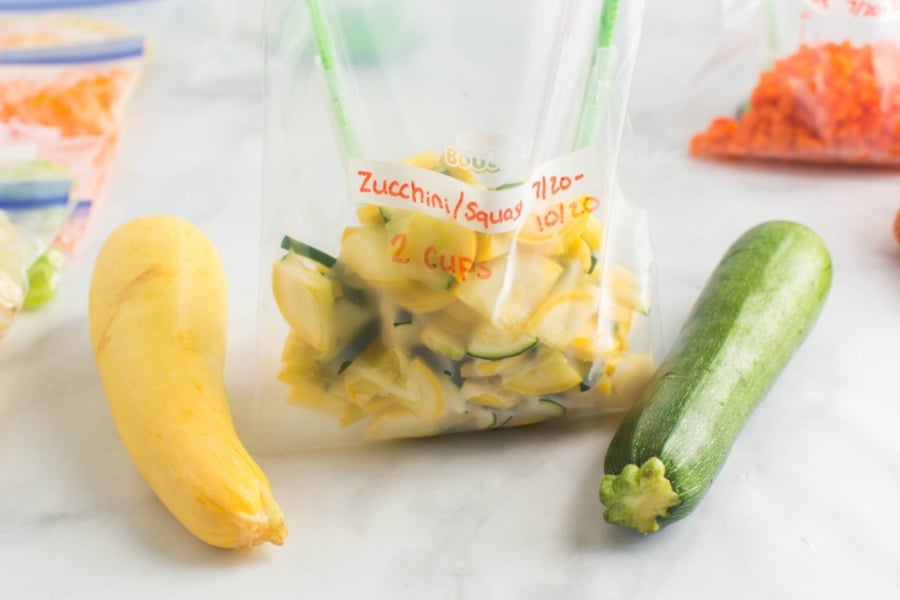How to Freeze Fresh Vegetables
Summer is a great time for vegetable lovers. The garden and the farmers’ market are brimming with fresh produce – tomatoes, sweet corn, carrots, bell peppers, zucchini to the max. Sadly, it doesn’t last. By November, that flood of fresh produce has dried up, and it’s back to the supermarket stuff again.
But here’s the good news: if you have a freezer, you can preserve that fresh-picked flavor. By freezing a portion of your crop now, you can have homegrown veggies to enjoy all winter long.
6 Steps to Freeze Fresh Veggies: Let’s start with the basics with these 6 steps
- Prepare. Wash your veggies and if using a steaming basket, cut into the desired size. I will get more specific on different requirements for different veggies.
- Blanch (cook in boiling water) the vegetables before freezing. Blanching stops the enzymes that keep the ripening process flowing. It also helps get rid of dirt and bacteria, retains the nutrients, and brightens the color. Use at least one gallon of water per pound of vegetables. Cook them in the water for one to two minutes. (Note: If you are freezing tomatoes, skip this step)
- Immediately after blanching, briefly dip the vegetables in a bowl of ice water until they are completely chilled.
- Drain the water and pat dry. If you are not using a steaming basket then at this point cut to desired size.
- Next you are going to get a freezer-safe container or baking sheet. Make a single layer of vegetables and freeze them until solid.
- Once frozen, pack them into freezer bags or use a vacuum sealer. You do not want them to come in contact with air. This will cause “off” flavors to develop by the time you defrost them.
Helpful Tips:
Email Me This Recipe!
Need to save time? Have this article emailed straight to your inbox + sign up for all the latest recipes!
- Freeze veggies within hours of picking or buying them to have the best flavor and texture after freezing. Pick ones that are not bruised or have any nicks in them for freezing.
- Blanching (scalding vegetables in boiling water or steam for a short time) is a must for almost all vegetables to be frozen. It stops enzyme actions which can cause loss of flavor, color and texture. Blanching cleanses the surface of dirt and organisms, brightens the color and helps retard loss of vitamins. It also wilts or softens vegetables and makes them easier to pack.
- Blanching time is crucial and varies with the vegetable and size. Under blanching stimulates the activity of enzymes and is worse than no blanching. Over blanching causes loss of flavor, color, vitamins and minerals. Use one gallon water per pound of prepared vegetables. Put the vegetable in a blanching basket and lower into vigorously boiling water. Place a lid on the blancher. The water should return to boiling within 1 minute, or you are using too much vegetable for the amount of boiling water. Start counting blanching time as soon as the water returns to a boil. Keep heat high for the time given in the directions for the vegetable you are freezing.
- Leave ½ in-1 inch of space at the top of the bags.
Here is the break down according to the requirements of different veggies.
- Celery: Celery is in the list of veggies that just won’t hold up well to freezing. It will be limp and may not hold its color. Now, this is not a good thing, if you are looking for a crispy snack or to add some crunch to a pasta salad. But if you are looking for the flavor of celery in a sauteed dish, a cooked casserole or a soup, then this is a great option to have pre-chopped celery ready to add to those dishes. Trim your celery stalks and then blanch for 3 minutes and follow the remaining steps. If you would like to chop them small before freezing you can do that or do it before adding to a dish. They will stay good in your fridge for up to a year.
- Carrots: Wash, peel and remove the tops. Cut into thin slices, 1/4-inch cubes or lengthwise strips. Blanch small whole carrots for 5 minutes, diced or sliced 2 minutes and lengthwise strips 2 minutes. Cool promptly, drain, pat dry and package, leaving 1/2-inch headspace. Seal and freeze. *Make sure you are using fresh carrots, otherwise they will taste rubbery when you use them later. They will stay fresh for a year.
- Zucchini/Yellow Squash: Wash and chop your zucchini and/or squash to the desired size. Then you will blanch for only 2 minutes. You do not want it to cook any more than that. Go directly to the ice bath and then freeze in a single layer on a baking sheet. Once frozen you can then move it to a freezer bag and freeze again. This is like the celery in the fact that you wouldn’t want this as a side dish, since it will lose some of its firmness, but is great to throw into your favorite soups, spaghetti sauces, and casseroles. Label and date your bag, it is best to use it within 3 months but it will last longer in your freezer, just know the longer it is in there, it will lose its flavor.
- Bell Peppers and Onions: These are the easiest veggies to freeze, because you skip the blanching and ice bath. Simply chop your onions as desired and for the peppers: remove the stems, seeds and membranes; cut them as you like. Then spread on a tray so they’re not touching each other. Pop them in the freezer till firm, then transfer to a freezer-safe zip-top bag with all the air pressed out or to a vacuum-sealed bag.
- Corn: You can freeze a whole ear of corn by simply shucking it and then (I personally, would cut it in half to make two mini ears of corn) placing it in a freezer bag, getting as much air out as possible and freezing. OR you can blanch the ears of corn for 2-3 minutes and then allow to cool till you can handle them. Cut off the kernels and place in a quart size bag, remove the air and freeze. These can last up to a year in the freezer.
- Broccoli: Cut and trim your broccoli into florets and stem pieces that are similar in size. Then you will want to wash them well to get all the dirt off. When you blanch these you will want to add salt to your water. Blanch for 3 minutes and then move to the ice bath. Next pat them dry and move them to a baking sheet lined with parchment paper. Freeze for 1-2 hours and then transfer them to the freezer bags. They will last up to 1 year.
- Potatoes: Peel and wash your potatoes. I then quartered them and blanched 3-5 minutes. Place them in the ice bath for 5-10 minutes and then cut into whatever size you are wanting. Pack in a freezer bag and remove as much air as possible.
I used these handy bag holders to help make this process even easier!
- Bag Holders (affiliate link)
Veggie Recipes We Love!
- Freezer Friendly Breakfast Croissant Sandwiches
- (Freezer Friendly) Breakfast Burritos
- Freezer Breakfast Quesadillas 4 Ways
- Healthy Frozen Banana Treats

How to Freeze Fresh Vegetables
Email this recipe!
Get this recipe emailed straight to your inbox!
Ingredients
- celery
- carrots
- bell peppers
- onions
- potatoes
- zucchini
- squash
- corn
- broccoli
Instructions
- Celery: Celery is in the list of veggies that just won’t hold up well to freezing. It will be limp and may not hold its color. Now, this is not a good thing, if you are looking for a crispy snack or to add some crunch to a pasta salad. But if you are looking for the flavor of celery in a sauteed dish, a cooked casserole or a soup, then this is a great option to have pre-chopped celery ready to add to those dishes. Trim your celery stalks and then blanch for 3 minutes and follow the remaining steps. If you would like to chop them small before freezing you can do that or do it before adding to a dish. They will stay good in your fridge for up to a year.
- Carrots: Wash, peel and remove the tops. Cut into thin slices, 1/4-inch cubes or lengthwise strips. Blanch small whole carrots for 5 minutes, diced or sliced 2 minutes and lengthwise strips 2 minutes. Cool promptly, drain, pat dry and package, leaving 1/2-inch headspace. Seal and freeze. *Make sure you are using fresh carrots, otherwise they will taste rubbery when you use them later. They will stay fresh for a year.
- Zucchini/Yellow Squash: Wash and chop your zucchini and/or squash to the desired size. Then you will blanch for only 2 minutes. You do not want it to cook any more than that. Go directly to the ice bath and then freeze in a single layer on a baking sheet. Once frozen you can then move it to a freezer bag and freeze again. This is like the celery in the fact that you wouldn’t want this as a side dish, since it will lose some of its firmness, but is great to throw into your favorite soups, spaghetti sauces, and casseroles. Label and date your bag, it is best to use it within 3 months but it will last longer in your freezer, just know the longer it is in there, it will lose its flavor.
- Bell Peppers and Onions: These are the easiest veggies to freeze, because you skip the blanching and ice bath. Simply chop your onions as desired and for the peppers: remove the stems, seeds and membranes; cut them as you like. Then spread on a tray so they're not touching each other. Pop them in the freezer till firm, then transfer to a freezer-safe zip-top bag with all the air pressed out or to a vacuum-sealed bag.
- Corn: You can freeze a whole ear of corn by simply shucking it and then (I personally, would cut it in half to make two mini ears of corn) placing it in a freezer bag, getting as much air out as possible and freezing. OR you can blanch the ears of corn for 2-3 minutes and then allow to cool till you can handle them. Cut off the kernels and place in a quart size bag, remove the air and freeze. These can last up to a year in the freezer.
- Broccoli: Cut and trim your broccoli into florets and stem pieces that are similar in size. Then you will want to wash them well to get all the dirt off. When you blanch these you will want to add salt to your water. Blanch for 3 minutes and then move to the ice bath. Next pat them dry and move them to a baking sheet lined with parchment paper. Freeze for 1-2 hours and then transfer them to the freezer bags. They will last up to 1 year.
- Potatoes: Peel and wash your potatoes. I then quartered them and blanched 3-5 minutes. Place them in the ice bath for 5-10 minutes and then cut into whatever size you are wanting. Pack in a freezer bag and remove as much air as possible.
Notes
- Freeze veggies within hours of picking or buying them to have the best flavor and texture after freezing. Pick ones that are not bruised or have any nicks in them for freezing.
- Blanching (scalding vegetables in boiling water or steam for a short time) is a must for almost all vegetables to be frozen. It stops enzyme actions which can cause loss of flavor, color and texture. Blanching cleanses the surface of dirt and organisms, brightens the color and helps retard loss of vitamins. It also wilts or softens vegetables and makes them easier to pack.
- Blanching time is crucial and varies with the vegetable and size. Underblanching stimulates the activity of enzymes and is worse than no blanching. Overblanching causes loss of flavor, color, vitamins and minerals. Use one gallon water per pound of prepared vegetables. Put the vegetable in a blanching basket and lower into vigorously boiling water. Place a lid on the blancher. The water should return to boiling within 1 minute, or you are using too much vegetable for the amount of boiling water. Start counting blanching time as soon as the water returns to a boil. Keep heat high for the time given in the directions for the vegetable you are freezing.
- Leave ½ in-1 inch of space at the top of the bags.
Nutritional Disclaimer: Family Fresh Meals is not a dietician or nutritionist, and any nutritional information shared is only an estimate. We recommend running the ingredients through an online nutritional calculator if you need to verify any information.
Did You Make This Recipe?
Make sure to share it with me below!
Steps I used are from https://share.upmc.com/2014/06/6-steps-freeze-fresh-vegetables/






















I loved how helpful this was for a Few veggies. I also had Brussel sprouts.
This is a very helpful guide.
Thanks Debra!